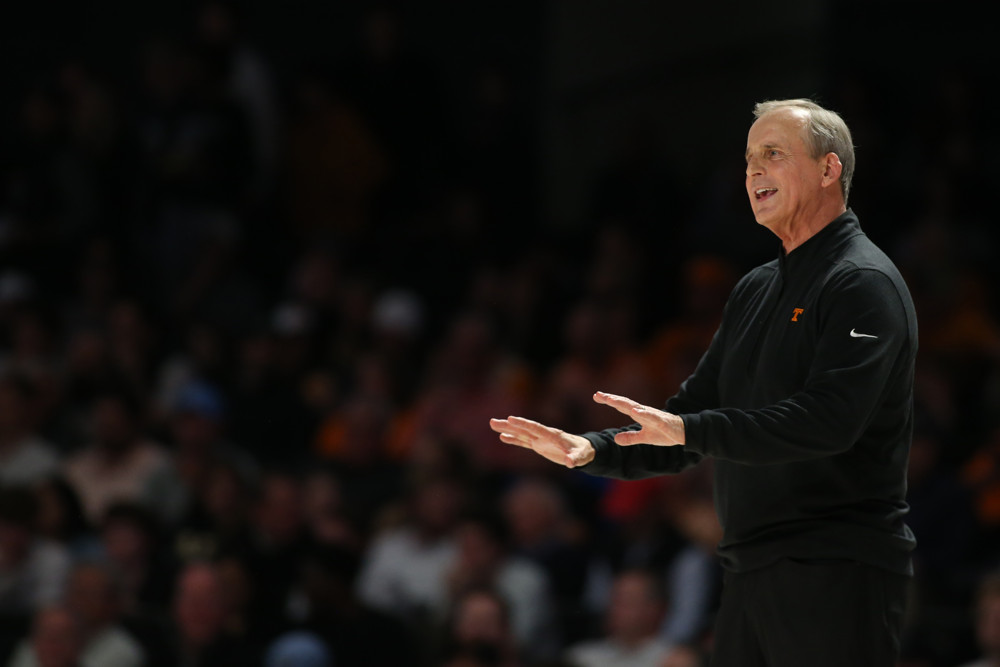If defense is the constant, predicting what we need on the offensive end is still a moving target. So, sure: make shots. The Vols are 227th nationally in effective field goal percentage, the lowest ranking of any of the Rick Barnes tournament teams in Knoxville. In SEC play, the shooting numbers probably aren’t quite as bad as you think: fifth in the league in effective field goal percentage, fifth in three-point percentage (at just 31.8%, so either the league is just really bad at it this year, or the grind is claiming everyone right now). Last year the Vols shot 36.8% from three in league play, a tenth of a point behind Kentucky at the top.
Shots going in would be great. The offense, as it’s always done under Barnes, seeks to create good shots through good ball movement, where Tennessee still leads the SEC in assist rate.
But when shots aren’t falling, where to turn? After the loss to Kentucky, we looked to offensive rebounding, noting the Vols were 14-0 when getting more than 25% of their misses. But in Gainesville, the Vols grabbed 36.7% of their misses and lost.
After the Vols beat Auburn shooting 9.5% from the arc, we noted that Tennessee was 14-0 when shooting 30+% from three, and 23-1 at that number last season. But in Nashville, the Vols shot 36.8% from deep and lost.
It’s still true that the defense is so good, getting just minimal results from three and hitting the offensive glass usually give the Vols every chance they need. But the Vanderbilt loss highlighted something that has quickly become a glaring note: the Vols are getting to the free throw line far less than the rest of the SEC.
On the year, the Vols are 210th nationally in free throw rate. The season-long ranking is not that different from what we’ve seen last season, or even in 2019, but both of those teams rated much higher in the shot-making department.
But in 11 league games this year, the Vols are getting to the free throw line on a league-worst 20.7% of their field goal attempts. The next-worst squad is South Carolina, a woeful 241st in KenPom and 231st in offense, who gets to the line at 26.8% in SEC play. Last year Missouri was worst in the league in free throw rate at 27.5%. The Vols improved in league play in 2022 to ultimately finish fifth at 36.6%.
How do you coach your team to get to the foul line more often? Attacking the basket unsuccessfully could lead to runouts the other way that negate Tennessee’s absolute strength on the defensive end, it’s true. Playing more through the bigs could lead to more free throws: Uros Plavsic gets free throws on 39.3% of his attempts (but is shooting 36.4% from the stripe), Tobe Awaka at 35.2%. Tyreke Key’s number is higher than I thought as well.
But by far, Julian Phillips leads the Vols (and is 49th nationally) in getting free throws on 59.3% of his attempts.
This might be more of an side note than a dot to connect at this point, but when Phillips attempts at least four free throws in a game, the Vols are 11-1 (with the loss to Colorado). In the other losses: two attempts at Arizona, none vs Kentucky, three at Florida, and the only two free throws of the game before the miss at the end at Vanderbilt.
You can also use that stat to see how the offense has changed, in part due to the availability of Josiah-Jordan James. Phillips attempted 65 free throws in Tennessee’s first 10 games. Since then, he’s attempted just 31 free throws. This is of particular note, of course, because James is down with a sprained ankle for the moment.
To me, the conversation about Phillips and his role in this offense is less about not dunking it in those final seconds at Vanderbilt, and more about what he could do for this offense in getting to the line, and how he does it better on paper than anyone else on this team.
It’s February 10, and the Vols are getting ready to face the most difficult portion of their schedule, we assume without Josiah-Jordan James for at least a minute. Keep playing defense, keep hitting the offensive glass, and sure, make shots. But the greatest room for improvement in this offense is in getting to the free throw line.
